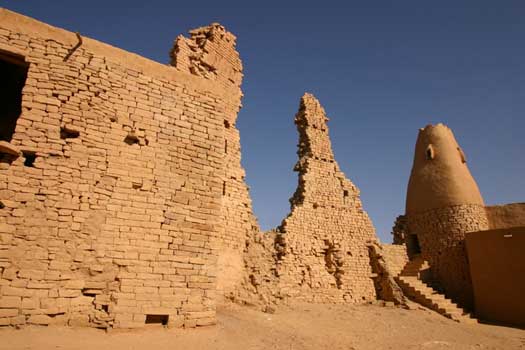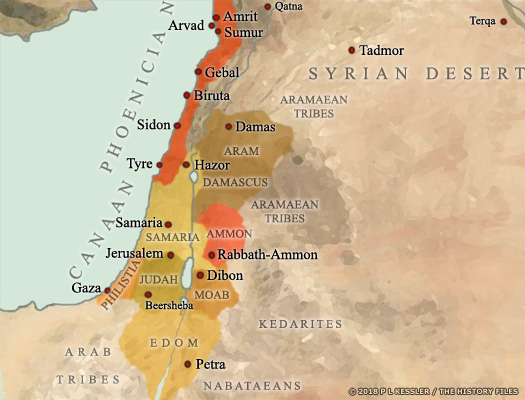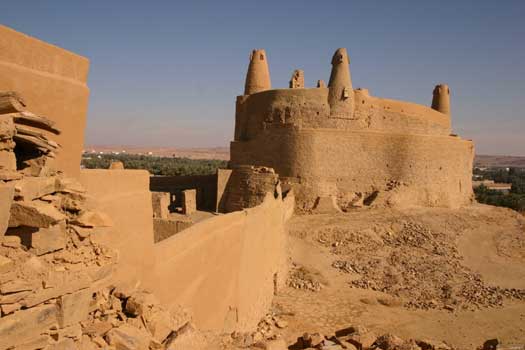
| KEDARITES / KEDAR Kedarites / Kedar (Qedarites / Cedarenes) :
The Kedarites were another nomadic Arabic people, just like their cousins, the Nabataeans. They occupied the desert regions of eastern Syria and present day Jordan, on the edge of the Levant. Also like their cousins, the Kedarites claimed an Israelite ancestor figure, this time being Kedar or Qedar, second son of Ismael (Ishmael), who was himself one of the sons of Abraham. The truth of the claim is debatable of course, as Abraham's sons are claimed as the founding fathers of many of the kingdoms which existed on the borders of ancient Israel. The Assyrians transcribed this name in the eighth century BC.
The Kedarites emerged into the historical record first as enemies of the Neo-Assyrian empire, to be defeated in battle, and then as vassals. From then on they suffered fluctuating fortunes at the hands of successive empires in the region. It is unclear whether they ever fully settled as a city-dwelling people. More likely, they remained a semi-transient tribal confederation to a large extent.
(Additional information by Lisa Elliot.)
fl c.1680s BC :
Kedar ben Ishmael : Son of Ismael of the Israelites.
9th century BC :
A Kedarite kingdom emerges on the eastern flank of the Levant, in eastern Syria and present day Jordan. Many small states have arisen by this time during the period of the Assyrian decline, with the Kedarite state being perhaps one of the last to emerge.
Adumattu, modern Dumat al-Jandal, was the Kedarite capital, now in ruins Kingdom
of Kedar (Qedar / Qidri) :
Subdued by the resurgent Assyrian empire in the ninth century BC, The Kedarite kingdom survived as a vassal state, occasionally rebellious, but mostly compliant. Its capital was at Adumattu, the Akkadian name for the modern archaeological site of Dumat al-Jandal in north-western Saudi Arabia. It may well have been founded by the Kedarites, since the earliest findings date to the tenth century BC, and for a time it was also home to an important temple dedicated to Ishtar. The kingdom's female rulers have been referred to as 'queens of Aribi'.
Following the destruction of the Neo-Assyrian empire in 612 BC, the Kedarites enjoyed the resultant power vacuum in the sixth century BC, controlling a large swathe of territory between the Sinai and the Persian Gulf. The Kedarites are also mentioned in Aramaic and Old South Arabian inscriptions, and it seems likely that they were subsumed within the Roman-controlled Nabataean state by the second century AD.
c.870 - 850 BC :
Gindibu : Arab leader at the Battle of Qarqar.
853 BC :
Gindibu is the leader of the Arab forces in an alliance of states which also includes Ammon, Arvad, Byblos, Damas, Edom, Egypt, Hamath, and Samaria. Together they fight Shalmaneser III of Assyria at the Battle of Qarqar which consists of the largest known number of combatants in a single battle to date, and is the first historical mention of the Arabs from the southern deserts. Despite claims to the contrary, the Assyrians are defeated, since they do not press on to their nearest target, Hamath, and do not resume their attacks on Hamath and Damas for about six years. Little else is known of Gindibu or the Arabs of this period, but it is likely that he is from the region of Kedar, and may be responsible for the creation of the kingdom following his success in battle.
When the Neo-Assyrian empire threatened the various city states of southern Syria and Canaan around 853 BC, they united to protect their joint territory - successfully it seems, at least for a time ? : Name unknown.
? : Name unknown.
? : Name unknown.
? : Name unknown.
c.850 BC - ? :
? : Name unknown.
? - c.750 BC :
? : Sixth unknown ruler uncertain.
c.750 - 735 BC :
Zabibe / Zabiba : Queen.
c.746 - 710 BC :
Samsi / Samsil : Queen.
c.710 - 695 BC :
Yatie / Iati'e : Queen.
704 - 701 BC :
With the death of Sargon II, many of the former Assyrian subject states rebel, especially Chaldaeans and neighbouring groups. Amongst the rebels are listed the Hagaranu (possibly the descendants of Hagar, the mother of Ismael), the Nabatu (very possibly the descendants of Nebayoth, the eldest son of the same Ismael), and the Kedarites (descendants of Ismael's second son). According to the records, these tribes flee from Assyria into the Arabian Desert and cannot be conquered. The use of 'tribes' here may be misleading. The Kedarite kingdom at least is already in place, so these may be captured and transported slave groups instead. With the recapture of Babylon a priority, it takes the Assyrians until 701 BC to get around to quelling similar rebellions in Judah and the Phoenician states.
c.690 - 678 BC :
Te'elkhunu / Te'elhunu : Queen, and high priestess of Atarsamain.
690 - 676 BC :
Hazael / Hazail : Co-ruler, and remained so for two years with Tabua.
c.678 - 675 BC :
Tabua : Queen.
676 - 652 BC :
Yauta ibn Hazail / 'Iauta / Uaite / Yawthi'i : Son of Hazail.
652 BC :
Abyate ibn Teri challenges Yauta ibn Hazail for control of the kingdom, but despite being successful, he never fully gains the support of his people.
652 - 644 BC :
Abyate ibn Teri c.652 BC :
Ammuladi / Ammuladin : Opposed Abyate ibn Teri.
c.650 - 644 BC :
Yaute / Uayte ben Birdadda : Opposed Abyate ibn Teri.
649 BC :
Shamash-shumi-ukin of Babylon rebels against his brother in the Assyrian kingdom. Ashurbanipal soon besieges Babylon, bringing it back into the empire. Rebellions in support of Babylon by the Kedarites and Nabatu are also put down, possibly prior to Babylon's recapture. It takes two years of direct rule before a puppet ruler of Babylon is placed on the throne, while the son of the Nabatu chief is declared leader of their people (his father's fate is not recorded).
644 BC :
Kedar is conquered by Assyria, possibly one of the empire's final acts of expansion.
? : Assyrian vassal, name unknown.
? : Assyrian vassal, name unknown.
? : Assyrian vassal, name unknown.
644 - ? BC : ? : Assyrian vassal, name unknown.
? - 610 BC :
? : Possible fifth Assyrian vassal, name unknown.
610 BC :
With the fall of Assyria, the Neo-Babylonian empire rises to fill the power vacuum, maintaining its grip on Kedar. During the sixth century BC there appears to be a movement towards Kedarite independence, with an apparently independent rule emerging at Dedan, although little is known of it or its level of success in remaining independent. Its disappearance in circa 550 BC suggests that it fails.
c.580 - 565 BC :
Mati-il : Ruled at Dedan.
c.565 - 550 BC :
Kabaril ibn Mati-il : Ruled at Dedan.
552 - 539 BC :
The Babylonian king, Nabonidus, moves his capital to Teima, deep in Kedarite territory. The Kedarites are a people with whom he has good relations, and the place feels safer to him than Babylon. His arrival is probably what causes the disappearance of the Kedarite 'state' at Dedan.
539 BC :
The Persian capture of Babylonia witnesses the rise of a new empire in the region, although Kedar remains a client state. Kedarites are employed as vassal rulers of southern Jordan and the Negev Desert.
Kedarite
Bedawi Kings
of Southern Jordan & the Negev :
During the Persian period, Moab disappeared from the historical record. The fate of the Moabites is not clear, but they may have been allowed to migrate northwards to fill Israelite lands that have been emptied by Nebuchadnezzar. The Edomites certainly were allowed to do just this, but they retained their identity while the Moabites seemed not to. Subsequently the territory was taken by tribes of Arabs which were now released to carry out their own northwards migration from Arabia, including the Kedarites and then later the Nabataeans. These peoples were allies of the Ammonites, although the country continued to be known as Moab for some time afterwards.
The Bedawis were a Kedarite/Kidarite clan, one of those which took part in the northwards migration and which rose to prominence under the control of the Persian empire. They were chosen to supply client kings to govern southern Jordan and the Negev Desert, which they did for the entire lifetime of the Persian empire.
539 - ? BC :
? : Persian vassal, name unknown.
? : Persian vassal, name unknown.
? : Persian vassal, name unknown.
? : Persian vassal, name unknown.
? - c.470 BC :
? : Possible fifth Persian vassal, name unknown.
c.470 - 450 BC :
Shahr I / Shahru c.450 - 430 BC :
Gashmu / Geshem ben Shahr : Son.
c.430 - 410 BC :
Quainu / Kaynau bar Geshem : Son.
c.410 - ? BC :
? : Persian vassal, name unknown.
? : Persian vassal, name unknown.
? : Persian vassal, name unknown.
? : Persian vassal, name unknown.
? - 332 BC :
? : Possible fifth Persian vassal, name unknown.
334 - 330 BC :
Persia is conquered by the Greek Empire under Alexander the Great.
Dumat al-Jandal later housed the fortress of Marid, shown here 332 - 323 BC :
Alexander the Great's Greek Empire rules the entire region until his death. Subsequently the empire is divided during the Wars of the Diadochi. Between 323-305 BC the wars see shifting fortunes and changes of ruler in the Levant, but the Seleucids emerge as the controlling power there. Little is known about the Kedarites, but it is thought that they remain in place as local rulers, administering the same territories as before. Unfortunately, none of their names have been preserved.
323 - c.250 BC :
The Kedarites fall out of Greek control, instead being dominated by the Lihyans.
c.250 BC :
Lihyan control of the Kedarites is superseded by that of the Nabataeans. Dated to 259 BC, the Zenon papyri mention that the Nabatu are trading Gerrhean and Minaean frankincense, transporting them to Gaza and Syria. They transport their goods through the Kedarite centres of northern Arabia, Jauf, and Tayma. Early Nabataean pottery can also be found in locations along the Persian Gulf, and around what is now coastal Saudi Arabia and Bahrain.
AD 106 :
Nabataea is conquered by the Roman empire, becoming the capital of the province of Arabia Petraea. Dumat is incorporated into the empire and the Kedarites lose their individual identity.
269 :
Zenobia, queen of Palmyra, mentions Dumat as a city with a fortress immune to conquest. The fortress of Marid subsequently withstands an attack by Rome during the queen's revolt against the empire, although it is unclear if this is because she has captured it.
5th century :
Towards the later part of the century, Dumat becomes the capital of the kingdom of Kindah.
633 :
The Islamic empire makes one of its first territorial gains when Khalid ibn al-Walid captures Dumat al-Jandal. Kedarite identity, if any remains by this time, becomes totally submerged within the empire in its various forms and successors over the subsequent fourteen centuries. In the modern age parts of it form the kingdom of Jordan.
Source :
https://www.historyfiles.co.uk/ |


